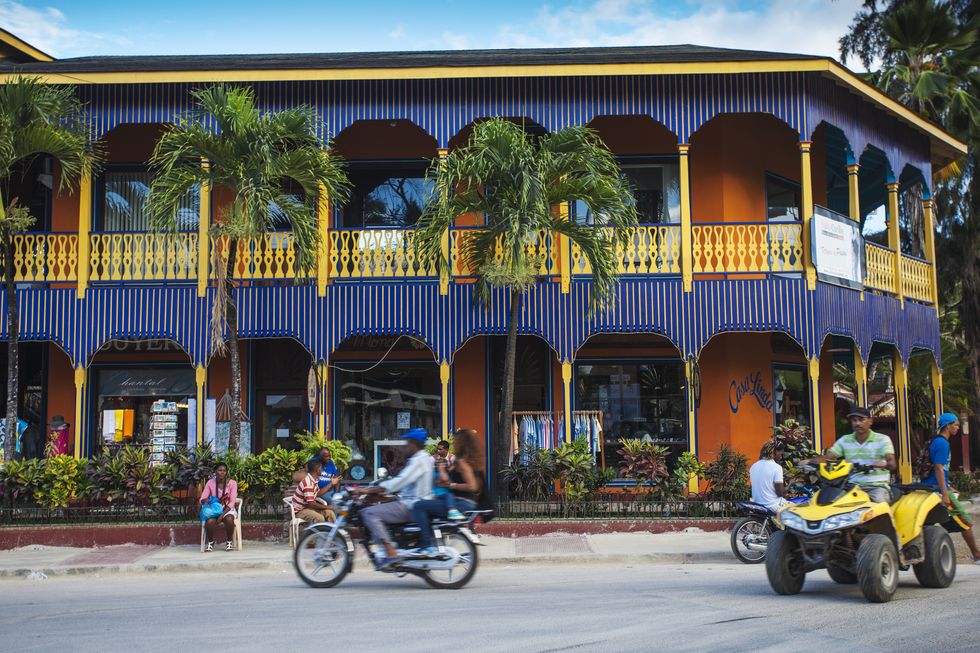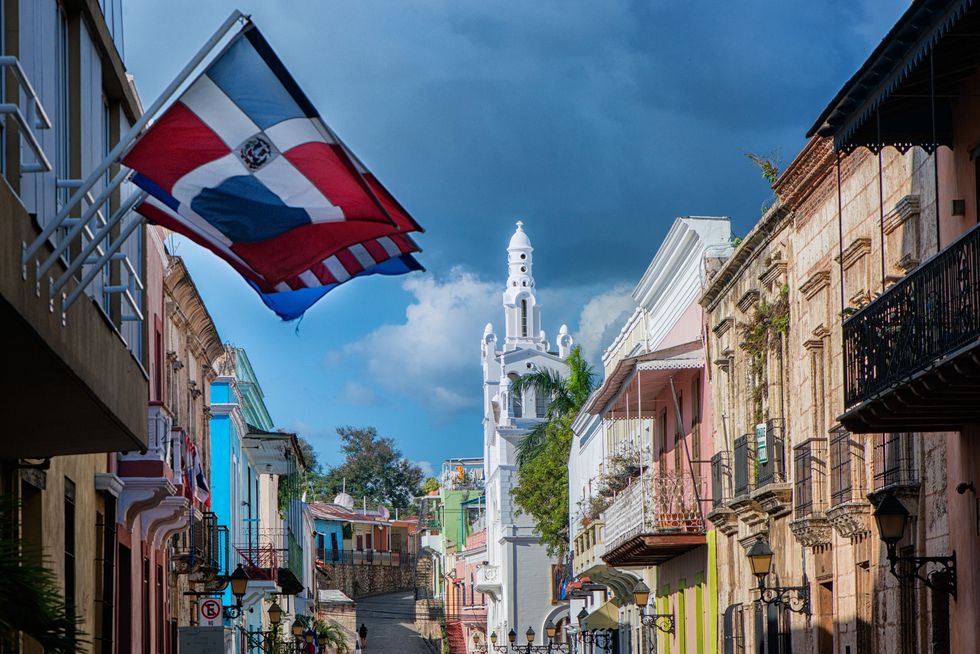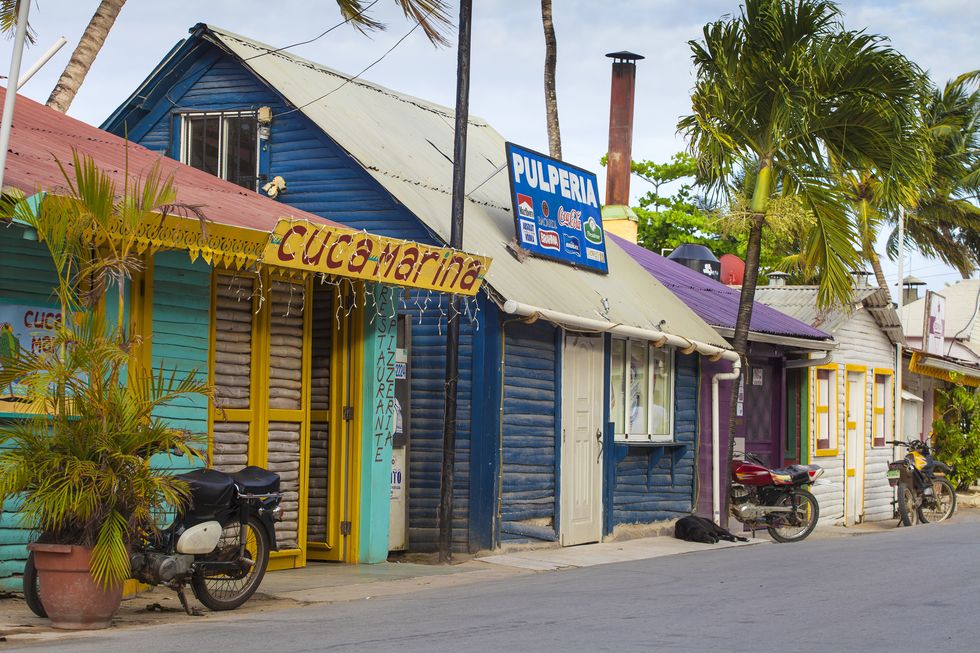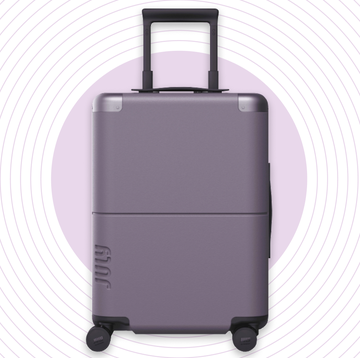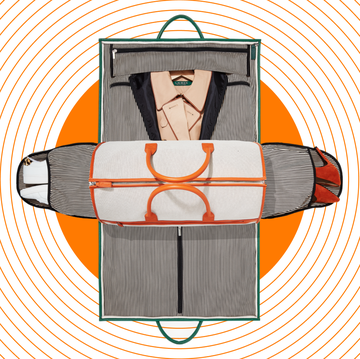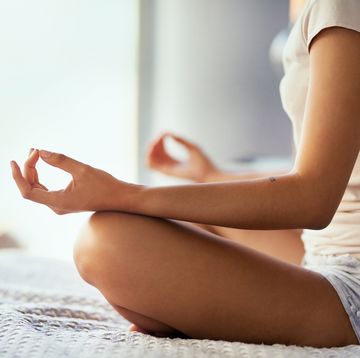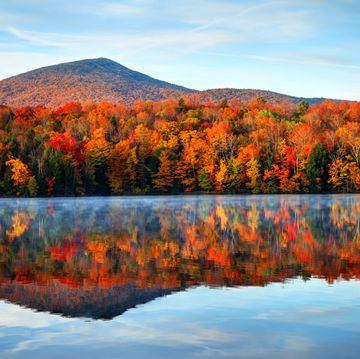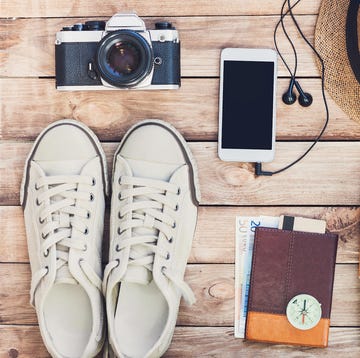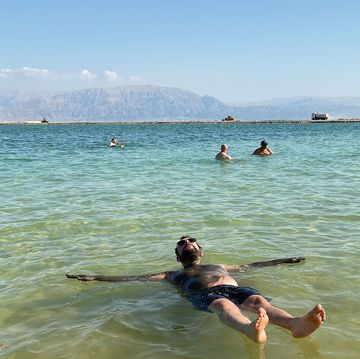Recent media attention has brought panic to the island of the Dominican Republic, where at least nine American tourists have died after staying at all-inclusive resorts. With each news update I see, my chest tightens. As a Dominican-American who recently moved back to the north coast of the island, every alarmist article or tweet declaring everyone "cancel DR" feels like a personal attack on my country.
“Mysterious Dominican Republic Tourist Deaths: The Victims So Far,” reads one headline on People. The New York Times writes that a “crisis” has hit the country. “Dominican Republic Tourism Has Dropped More Than 74 Percent,” cites a new report from The New York Post. Meanwhile, on social media, commenters are calling the D.R. a “murderous island,” suggesting that everyone “leave that country.” Airlines like Delta and JetBlue are waiving change fees for anyone who had flights to the D.R. And when actor Miles Teller recently told Jimmy Kimmel on his late-night show that he had his bachelor party in the Dominican Republic, Kimmel joked: “Was there no availability in Syria?” Yes, he compared the Dominican Republic to Syria. A war-torn country.
Before you read stories like the above and come to your own conclusions about the Dominican Republic, I’m here to ask that we all take a deep breath and consider the entire picture. Because while what’s happening is incredibly tragic—my heart breaks for the families who are searching for answers for their loved ones lost too soon*—as a Dominican, I feel a responsibility to remind the world that the deaths that have occurred at six all-inclusive resorts do not reflect an entire country of more than 10 million people. As unfortunate as these incidents have been, our beautiful island does not deserve to be blacklisted—and with normal travel precautions, you can still have a safe trip to the Dominican Republic.
More From Oprah Daily

I know firsthand just how proud Dominicans are—and how genuinely we care about giving visitors a good impression. It’s only natural, given that tourism is one of the main pillars of our economy. Last week, I rode a local motoconcho, or motorcycle taxi, in the beach town of Cabarete, where I’ve been living for the past eight months. The driver informed me that I was his first customer of the day; it was roughly 2 p.m., and he was unable to send money to his kids for lunch that day—money he usually earned from giving rides to tourists. A few days ago, while grabbing my daily fresh coconut during a break from my work as a yoga teacher, I overheard two gentlemen at the store whispering with fear over how their business would be impacted by the news. With each new headline, report of trip cancellations, or social media comments quoting facts taken out of context, these are the innocent people being affected by the never-ending news cycle.
The hysteria is only further adding to our unfair reputation as a country that's “violent" outside of resorts—sadly ironic, given that the recent deaths in the Dominican Republic have allegedly been connected to stays at resorts. (And none have been violent in nature.)
Yet the constant headlines using the word “victims” suggests that visitors are being attacked and murdered, even though experts agree that the circumstances of the recent deaths are not violent and appear to be isolated incidents. In fact, tourist deaths in the Dominican Republic have actually gone down in recent years, according to NBC, including this year. Still, as The New York Post pointed out, the D.R. is seeing a decline in tourism—during what is already our “low season,” or the time we see the least amount of visitors, because of hurricanes.
It’s not just motoconchos like my driver who rely on the yearly influx of visitors to make their living: It’s the workers who wait tables at restaurants, the cooks in the kitchens, the store owners, the housekeepers, the maintenance workers, and the airport employees. In a developing country like the D.R., these manual jobs are filled by the working class. And with every piece of information irresponsibly shared through an article or tweet, their daily livings take another blow.
Still, there’s a lingering question: What is happening at these resorts in the Dominican Republic—and why have nine Americans recently died? The United States Department of State, the FBI, and the Dominican Ministry of Tourism are all investigating, and none have yet reached any conclusive results. But so far, the ongoing belief seems to be that bootleg alcohol may have caused illnesses that led to these sudden deaths, as many of the deceased were found to have been drinking alcohol at their resorts or from their minibars.
Counterfeit alcohol is a real concern, but one that isn’t new, nor unique to the Dominican Republic.
Counterfeit alcohol is a real concern, but one that isn’t new, nor unique to the Dominican Republic. The International Alliance for Responsible Drinking classifies illicit alcohol as unregulated and unrecorded alcohol, which can be anything from alcohol that was tampered with to alcohol that was smuggled in from elsewhere.
The same report found that in 2016, 29 percent of alcohol in the Dominican Republic was illicit. And in 2013, 34 percent of liquor in Mexico was also counterfeit, while in 2018, tainted alcohol was reported throughout Mexican all-inclusive resorts after tourists reported illnesses. Earlier this year, illicit alcohol killed 154 people in India.
As a result of the recent news, the Hard Rock Hotel announced in a statement that they are removing liquor dispensers from in-room minibars and hiring a U.S. healthcare company to test all food and drinks. As of press time, I had not heard back from The Hard Rock for further statement. But the Bahia Principe responded that following their initial comments about the three guests who died after visiting their property—which you can read in full here—they have nothing else left to say. "After that, we decided not to do any further declarations, after inaccurate and false information has been spread or circulated of by various media, digital platforms and social networks," they wrote via e-mail.
While I’m here defending my country, I should clarify that I will never defend the all-inclusive resorts who have found themselves in the news. These are the same massive hotels—most of them foreign-owned—that swoop in and suck up many Dominican beaches and privatize them, then limit access to Dominican residents. In Punta Cana, if you are not working at a resort or in hospitality, your job options are limited, and the average Dominican does not have any say on who is allowed to invest in tourism. Yet we are the ones—the hard-working people who call this island home—who are losing jobs and suffering as misinformation continues to spread.
Experts at both NBC News and Business Insider maintain that nothing unusual is happening in the Dominican Republic—and that applying the label of "dangerous" to the nation is not only unfair, but inaccurate. Business Insider reports that even if violence was a threat, the murder rate in the country is actually lower than many U.S. cities—and “on the decline.”
For context, the murder rate in D.R. was 10.4 per every 100,000 people in 2018. For comparison, in 2017, St. Louis Missouri saw 66.1 murders per every 100,000 people; Baltimore saw 55.8, and in Detroit, there were 39.8. That means that the Dominican Republic is far less dangerous than some of the U.S.’s most well-known cities. As CNN points out, Americans are more "likely to be killed in the U.S. than in the Dominican Republic."
Americans are more likely to be killed in the U.S. than in the Dominican Republic.
Even the United States Department of State has not given the American public any cause for alarm. There are no travel alerts put in place, and the Dominican Republic’s travel advisory status has been classified as a “Level 2: Exercise Increased Caution” out of four rankings since April. To put that in perspective, Germany, Belgium, and Italy are all also currently at a Level 2.
A representative for the Department of State, Peri Farbstein, tells OprahMag.com that so far, it looks as though the travel advisory will remain at a level 2.
“Local authorities report they have not found a connection between the cases during the initial stages of their investigation,” Farbstein said of the recent deaths. “Should we learn of safety risks to the public through the investigation, we will share that information.”
So if there is no evidence of violent deaths, and danger in the Dominican Republic has actually gone down in recent years: Why the ongoing panic and smearing of the Dominican Republic in the news and on social media? Travel expert Lee Abbamonte, who has traveled to every country in the world, believes people are simply responding to the feeling of panic.
“It’s in the American DNA to have knee-jerk reactions to this kind of thing—but let’s be honest, America is not the safest place to visit, either,” says Abbamonte. “People should be cautious in the same way they would be cautious in any place they visit. These are unfortunate occurences—but not terrorists attacks, or anything that seems malicious or premeditated. Personally, it doesn’t prevent me from wanting to visit the D.R.”
So if after considering all of the facts, you do want to visit the Dominican Republic, Doctor Jonathan Goméz, a gastroenterologist at the Centro Medico Cabarete in Cabarete, says that doing so safely is always possible—but recommends taking the top two precautions that anyone should take while visiting a foreign country. First, he recommends you avoid drinking tap water, a suggestion made when traveling to developing countries. Second, be careful buying street food, which may not always be properly prepared.
And as the second largest country in the Caribbean after Cuba, there is much of the Dominican Republic to see beyond just the areas where these unfortunate resort incidents have occurred. (To give you an idea of its size, my home in Cabarete is nearly a six-hour drive away from Punta Cana, the eastern city many American tourists flock to.)
Gerry Isabelle—a first generation Dominican-American and founder of the travel lifestyle site Dominican Abroad—wants to debunk the myth that it’s too dangerous for tourists to travel outside of their resorts, particularly now that it's exactly those establishments that are coming under fire.
“Labeling the areas outside of hotels as dangerous is a myth usually perpetuated by the resorts, likely in an effort to be the sole profiteer of a traveler’s spending—if they keep you inside, they can then charge up to 10 times the price for products and services!” says Isabelle, who offers immersive travel experiences in the D.R. and Cuba through her site.
“I try to remind travelers that there are people from all over the world who have moved to the Dominican Republic because they fell in love with our island, everywhere from the U.S. to Russia, Korea, and more. They come from different ethnic groups and speak many foreign languages, and they love it as much as those of us who were born here.” She suggests intrepid travelers skip Punta Cana and head instead to areas like Monte Cristi, Jarabacoa, Pico Duarte, Pedernales, and Samaná.
Lebawit Lily Girma, a Caribbean travel expert and author of the Moon Dominican Republic guidebook, echoes those sentiments, emphasizing that staying in just one resort in a tourist destination is like getting a watered down version of the culture. Plus, there are plenty of options beyond resorts, like renting local houses on websites like Airbnb.
“Punta Cana is completely shut off from the rest of the country—even the road connections are few and far between,” Girma says. “And if you are nervous about traveling to the D.R. right now, it doesn’t hurt to try to talk to people who are from here! Many speak English, and everyone is more than willing to guide you. As a country that depends on tourism, no one here gains anything from any death.”
In response to the negative press, lovers of the island like myself have contributed to hashtags like #BeFairWithDR, which were created in response to the media cycle and social media outrage. Take a peek if you want to see more perspectives from both Dominicans of the diaspora and past visitors who share a passion for this place. There’s a reason why tourists often return—and many even eventually call the island home. In recent years, locals like myself have noticed the expatriate community is growing, particularly in the capital city of Santo Domingo and the beach town of Las Terrenas.
Of course, travelers should always be cautious and respectful of their surroundings. And it’s only right that this recent influx of news would cause alarm. But to you, reader, I ask that you be considerate and responsible when spreading news—because in this case, it is cruel to punish a developing country for the circumstances of a few, however tragic. And should you ever want to visit the Dominican Republic, many people like me would be happy to show you all that this beautiful island has to offer—outside of its resorts.
*On June 21, the Dominican Ministry of Tourism held a press conference to give an update on the investigations of the eight deaths that had occurred in 2019. The eight deaths as of the 21st, according to Tourism Minister Francisco Javier García Minister Garcia, included:
1. Jerry Curra, who was staying at the Dreams Resort Punta Cana and died of pulmonary edema, cerebral hypoxia, subdural hematoma, and severe traumatic brain injury.
2. Robert Bell Wallace, who stayed at the Hard Rock Hotel & Casino in Punta Cana and died of septic shock, pneumonia, and multi-organ failure.
3. John Corcoran, who died of natural causes—and whom his sister, Shark Tank judge Barbara Corcoran, confirmed had a pre-existing heart condition.
4. Miranda Schaup-Werner, who was staying at the Bahia Principe hotel and died of a heart attack, pulmonary edema, and respiratory failure.
5. Nathaniel Holmes and Cynthia Day, guests at the Playa Nueva Romana with reported causes of pulmonary edema and respiratory failure.
6. Leyla Ann Cox, who died of acute myocardial infarction, with other medical findings suggested a previous heart attack.
7. Joseph Allen, who stayed at the Terra Linda resort in Sosua and died of a heart attack.
Toxicology reports are pending for Miranda Schaup-Werner, Nathaniel Holmes and Cynthia Day.
For more stories like this, sign up for our newsletter.
Moraima Capellán Pichardo is a Dominican-American writer, visual creator, and yoga teacher. Raised in Brooklyn, New York, Moraima is currently based in Cabarete, Dominican Republic. She has written for the Huffington Post, La Galeria Magazine, and Healthista, among others. Find her work at moraimacp.com, or on social media at @moraima_cp.

